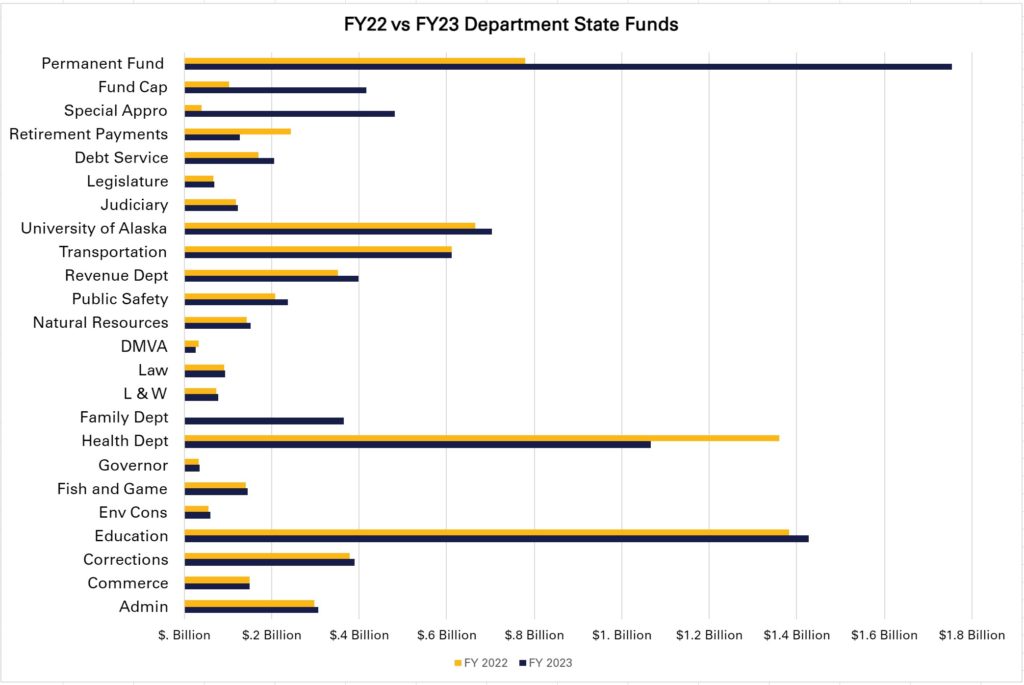
By Quinn Townsend – (Alaska Policy Forum)
Alaska Policy Forum’s annual Budget Blocks are a simple, straightforward way to visualize how Alaska is spending its money and from which funds that money is coming. The size of each block corresponds to the amount allocated to each state agency or department in the operating budget. The larger the dollar amount, the larger the block. All of the numbers are taken straight from the FY 2023 Enacted Operating Budget agency summaries provided to the public by the Alaska Division of Legislative Finance. The Office of Management and Business (OMB) also provides similar numbers in a slightly different format.
This year, the Department of Health and Social Services was split into two separate departments, the Department of Family and Community Services and the Department of Health.
The Fund Capitalization portion of the budget is much larger than in previous years, due mainly to the addition of the Higher Education Investment Fund (HEIF), a scholarship fund. Whatever money is not used by the scholarship fund by the end of the fiscal year is typically transferred into the Constitutional Budget Reserve. This year, Alaskan legislators voted not to transfer the unused funds, keeping the HEIF as fund capitalization.
Additionally, the Permanent Fund portion of the budget (which includes the draw from the Earnings Reserve Account) is larger due to increased PFDs and an energy relief payment. In the FY 2023 enacted budget, approximately 62% of the Permanent Fund block is allocated for PFDs and an energy relief payment. In FY 2022, 15% of the Permanent Fund block was allocated for PFDs and in FY 2021, about 28%, as calculated from OMB fiscal summaries.
Explanation of Terminology
The operating budget covers ongoing operations and expenses for the State of Alaska, or the day-to-day running of the government and state programs. According to OMB, it is “annual appropriations covering ongoing operations. Appropriations are typically made for a fiscal year, with funds lapsing at the end of the fiscal year.”
AGENCY OR DEPARTMENT
— Department of Administration (Admin)
— Department of Commerce, Community, and Economic Development (Commerce)
— Department of Corrections
— Department of Education and Early Development (Education)
— Department of Environmental Conservation (Env Cons)
— Department of Family and Community Services (Family Dept)
— Department of Fish and Game
— Office of the Governor
— Department of Health (Health Dept)
— Department of Labor and Workforce Development (L & W)
— Department of Law
— Department of Military and Veterans’ Affairs (DMVA)
— Department of Natural Resources
— Department of Public Safety
— Department of Revenue (Revenue Dept)
— Department of Transportation and Public Facilities (Transportation)
— University of Alaska
— Judiciary
— Legislature (Leg)
— Debt Service – The state pays back loans or bonds that have been issued for new projects.
— State Retirement Payments – Deposits to the pension fund for state and school district employee retirement obligations.
— Special Appropriations (Special Appro) – Bonds for tax credit purchases, Alaska comprehensive insurance program, and shared taxes, such as the salmon enhancement tax and the fisheries business tax.
— Fund Capitalization (Fund Cap) – Money set aside for various funds, such as the Higher Education Investment Fund.
–Permanent Fund – Permanent Fund Earnings Reserve Account (ERA) appropriations, which include the PFD payments.
— Unrestricted General Fund (UGF) – Non-federal money with no statutory restrictions; the legislature has the discretion to spend this money however it chooses.
— Designated General Fund (DGF) – Non-federal money that is statutorily designated for a specific purpose. According to the Alaska Division of Legislative Finance, “The legislature traditionally complies with designations, but may use these funds for any purpose at any time.”
— “Other” State Funds – Non-federal money that the legislature has limited discretion over.
— Federal Receipts – Funds received from the federal government.
The graphic titled “Agency Totals” depicts budgeted expenses to be paid from the UGF, from the DGF, from “Other” state funds, and from federal receipts.

The graphic titled “Agency State Funds Only” excludes federal receipts from the department totals and includes UGF, DGF, and “Other” state funds.

The graphic titled “UGF Only” includes only Unrestricted General Funds.

The graphic titled “State Funds per Capita” depicts all department budgeted expenditures from state funds per capita, based upon Alaska’s most recent population numbers.

The graphic titled “FY 22 vs FY 23 Department State Funds” compares FY 2022 budgeted state funds with FY 2023 budgeted state funds for each department or agency.









2 Comments
So this looks like yhe University and Education needs a big cut. We already know we’re at tge bottom of any list in these two areas. We also over the past 10+ years know throwing more money at it has not worked. its time to look seriously at these two and do some cutting. I’d say the administration needs a serious pay cut. Heat, lights, food and housing is always going to be their.
Anything “woke” needs to be cut, CRT, drag queens, no creeps hiding behind their false shield of being woke. Garbage in, garbage out.